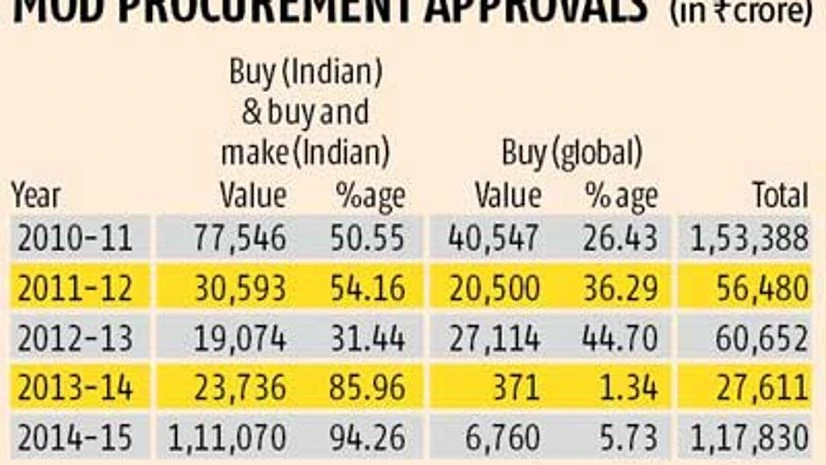Speaking in New Delhi on Monday, the defence ministry's secretary in charge of defence production, AK Gupta, announced an ambitious target to "achieve a level of 70 per cent [defence] indigenisation by 2027." Analysts regard this as unrealistic, considering that Gupta himself estimates that "the indigenous content in total defence capital procurement across all the three services has been hovering around 40 per cent in [the] last couple of years."
Pointing out that total indigenisation would be unrealistic, Gupta said, "Practically, it may be possible to achieve 60 per cent indigenous content along with capabilities in crucial technologies like aero engines, avionics, precision electronics, sensors and radar technology etc., in next five years, with a target to reach 70 per cent in further five years."
This, he said, would "take volume of defence exports to $1 billion (Rs 6,675 crore) in five years and $3 billion (Rs 20,025 crore) in next 10 years."
Defence Minister Manohar Parrikar, while speaking in Panaji in August, had placed defence exports in 2014-15 at about Rs 630 crore ($94 million). Meeting the new targets would involve boosting defence exports 10-fold in five years, and 30-fold in a decade.
Gupta presented figures to illustrate the progress towards indigenisation. Compared to 2010-11, when just half of all procurement approvals were in the largely indigenous "Buy (Indian)" and "Buy and Make (Indian)" categories, this went up to 86 per cent in 2013-14 and 94 per cent in 2014-15.
Gupta did not mention that, notwithstanding the "Indian" in the names of these categories, "Buy (Indian)" category demands only that the equipment be at least 30 per cent indigenous by value. The "Buy and Make (Indian)" category requires the equipment to be at least 50 per cent indigenous by value.

Highlighting the peripheral role played by the Indian private sector, Gupta revealed that 90 per cent of India's total defence manufacturing output comes from the ministry's eight defence public sector undertakings (DPSUs) and 41 ordnance factories. These employ close to 1,60,000 workers. Gupta, however, suggested that things were changing. Since the Indian private sector was allowed into defence production in 2001, "182 Indian companies have been issued 307 industrial licenses for manufacture of licensable defence items till October, 2015. So far 50 companies, covering 79 industrial licenses, have informed about commencement of production." The largest share of 88 industrial licences has been granted in the fields of radar/ electronics systems/ radio/avionics. In addition, 51 licences have been granted for building rockets/missiles/torpedo/air defence guns/unmanned aerial vehicles. Another 38 licences relate to aeronautics; while 37 licences have been granted for night vision/sensor based systems/optical goods.
With offsets frequently cited as a key driver of indigenisation, Gupta revealed, "25 defence offset contracts are under implementation with offset obligations of approximately Rs 29,274 Crore ($4.87 billion). The(se) offset obligations… extend over a period of 14 years i.e., from 2008-2022." Another 45 cases worth $8-10 billion approximately are under different contracting stages."
Further, 34 Joint Ventures (JVs) have been approved for manufacture of defence equipment.

)
